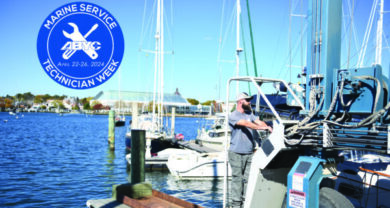Retail numbers up for 2004
Total retail expenditures on boating increased eight percent in 2004, climbing to $33 billion, and highlighting the “Recreational Boating Statistical Abstract” published by the National Marine Manufacturers Association.
Citing a rising consumer confidence index throughout most of ’04, NMMA President Thom Dammrich said, “Boat sales benefited from a strong economy in 2004. The Gross Domestic Product increased 3.6 percent, unemployment experienced steady decline, and consumer confidence reached its apex in July, at the peak of the boating season. All these factors combined to make 2004 an outstanding year.”
Leading the way in growth were aftermarket accessory sales, which recorded a 14-percent increase to $2.4 billion, a total which is nearly double that from 1997. That growth, Dammrich noted during a press luncheon at the American Boating Congress in early May, is most likely attributable to the fact that more and more pre-owned boats are changing hands these days.
The last time NMMA completed a study on the pre-owned boat market was in 1998, when 60 percent of the boats on the market were purchased pre-owned. In a report scheduled to be released soon, that number has climbed to 70 percent. Dammrich said that between 7 and 8 million pre-owned boats changed hands last year, and suggested that the increase in accessories could be due to the possibility that pre-owned boat buyers probably see a need to upgrade their accessories.
Jim Petru, director of market research for NMMA, suggested that accessories might also be in demand because consumers want to turn their boats into a “home away from home” upgrading them with state-of-the-art entertainment equipment like computers, DVD players and satellite radios.
Boat sales up, too
With the large increase in accessory sales, boat sales shouldn’t be overlooked. In fact, all major industry segments tracked in the Abstract saw an increase in sales.
New boat sales increased 7.2 percent, to $10.75 billion in 2004, while pre-owned power boat sales reached $7.9 billion, a 7.3-percent increase. New outboard engine sales totaled $2.9 billion, a 12.8-percent increase; pre-owned outboard sales increased 12.7 percent, to $1.8 billion. And trailer sales reached $228 million, representing a 12.9-percent increase.
Seven of the 10 boat categories saw positive unit sales growth in 2004, according to the Abstract. Unit sales for inboard cruisers (6.2 percent over 2003) and outboard boats (4.6 percent) led the way, while ski boats, sterndrives, canoes, kayaks and inflatables also recorded increases.
On the whole, unit sales climbed by 4 percent over 2003.
Exchange rate improves
Also of note was the fact that favorable exchange rates resulted in a 30-percent decline in the boating industry trade deficit, as the value of exported boats and engines increased 42.7 percent, to $1.5 billion. Boat and engine imports only increased 5.6 percent, to $2.3 billion, leading to a trade deficit of a little more than $795 million, down from $1.13 billion in 2003. It’s also at its lowest level since 2000.
Western Europe was reported as the biggest market for U.S. exporters, accounting for 38 percent of total exports, followed by Canada (27 percent) and the Australia/Pacific region at 12 percent.
What about 2005?
A number of factors have the NMMA president optimistic about 2005 — but only cautiously optimistic.
The consumer confidence rating has dipped a little bit early this year, in fact it began to dip late last year, and with that, both the recreational vehicle market and the marine industry have seen small declines in unit sales in March and April. Trends in the marine industry track similarly to those in the RV industry, actually lagging behind it by a few months or so.
Other factors suggest that the marine industry could experience another growth year. Although interest rates are creeping up, they aren’t close to 5 percent yet, which is where, Dammrich says, they begin to affect the boating industry. Unemployment is low. Gross Domestic Product is doing well.
“We’re optimistic we’ll have another year of growth this year,” he said, “but probably a little more cautiously optimistic than we might have been a few months ago.”




